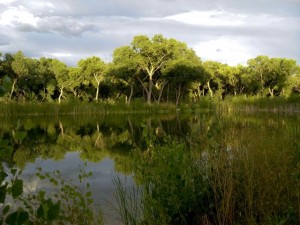Lissa and I were walking in the Rio Grande bosque, the riparian cottonwood forest, last night when the sun dropped below the clouds just before sunset and lit the trees across the pond with the most exquisite light. All we had was a cell phone camera, so I went back this evening at the same time hoping for the best. Nature did not disappoint.
Much like the Las Vegas Wash I wrote about in the spring, this is not “nature”. People built this pond as a habitat restoration project. It’s become a favorite birding and walking spot for us. This evening I saw a pair of summer tanagers dining on extremely large bugs in the cottonwoods. A ruddy duck and a coot were sitting on a jam of floating wood at one end of the pond. On the downstream end, the water spills out into a rich cattail marsh, all muddy and rich with bugs and birds. This year pampas grass has grown in towering clumps along the pond’s edge, and Lissa and were pondering whether someone had planted them, or whether they seeded themselves, escaped from gardens in the Country Club neighborhood just off the river to the east.
If this was nature, the Country Club neighborhood would be a swamp, and the riverside woods wood be clumps of cottonwoods here and there, rather than a ribbon of trees locked into a narrow corridor by levees.
Nature or not? Important not to get too hung up on the question. I’d miss the lovely.


I don’t mean to belabor the nature question but this Wired Science item has an interesting presentation on how most ecosystems now are “created by and ruled by human activity.”
http://www.wired.com/wiredscience/2010/08/new-anthrome-maps/
Have you checked out the new Perennial Marsh at the Open Space Visitor Center? It is developing nicely. Not the easiest place to get on a bike, but possible.
This OSVC marsh, like so many of our people built water features, has no shallows for shorebirds to rest/feed during migration. Don’t know why this is nearly always overlooked.
It sounds like this is a successful ecosystem restoration project (and it looks beautiful) but some wetland replacement projects are pretty shoddy…needing lots of management and dredging. Sometimes, you can’t just move a wetland half a mile to the side because the morphology of the land won’t support it. You have to be thoughtful in where you place them.